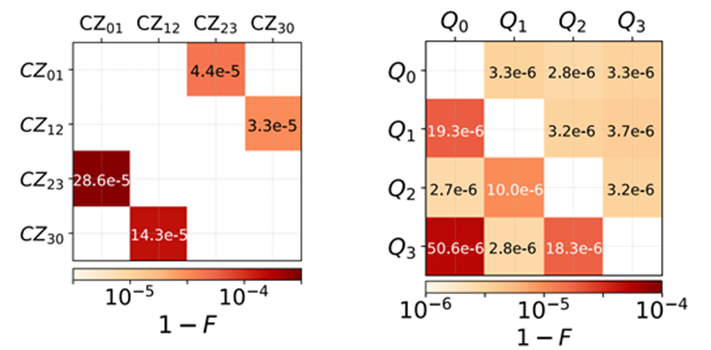PRX Quantum: Simultaneous Gate Operations on Superconducting Qubits
2022/04/22
Recently, the Superconducting Quantum Computing Group of Beijing Academy of Quantum Information Sciences analyzed the crosstalk errors and their impact on the parallel quantum gates in detail, which can provide inspiration and meaningful guidance for the design of scalable superconducting quantum processors. Relevant work was published on PRX Quantum under the title of Quantum Crosstalk Analysis for Simultaneous Gate Operations on Superconducting Qubits.
In the practical implementation of quantum processors, an outstanding challenge is how to maintain or even improve gate performance with growing numbers of parallel controlled qubits. For quantum processors built with superconducting qubits, isolated single-qubit gates with gate error below 0.1% and two-qubit gates with gate error approaching 0.1% have been demonstrated in various qubit architectures. However, in multiqubit systems, implementing gate operations in parallel has commonly shown worse gate performance, especially for simultaneous two-qubit gate operations applied to nearby qubits. Generally, the performance degradation is caused by the crosstalk effect that breaks the textbook assumption on quantum computing, i.e., gate operations are implemented spatial locally and independently. Moreover, this crosstalk effect can cause not just increased gate errors but even a variety of correlated and non-local errors, which are particularly harmful to the realization of fault-tolerant quantum computing.

Fig. 1 (a) Sketch of a coupled two-qubit system. (b) Circuit diagram of two fixed-frequency transmons coupled via a frequency-tunable transmon (treated as a tunable bus).
In this work, we first propose a qubit architecture with tunable ZZ coupling, where fixed-frequency transmon qubits are coupled via a tunable bus, and sub-100-ns CZ gates can be realized by applying a fast-adiabatic flux pulse to the bus. Then, we thoroughly analyze the quantum crosstalk impact on simultaneous gate operations in this qubit architecture. In general, we find that characterization of isolated gate errors, especially, with all nonparticipating spectator qubits in their ground states, cannot capture the full physical picture of error sources behind simultaneous gate operations. Given this insight, we exam- ine the isolated gate performance with nonparticipating spectator qubits in various state configurations. Combined with an inspection of the system dynamics during gate operations, we find that to ensure high simultaneous single-qubit gate fidelities, dressing-induced cross driving should be seriously considered when one operates qubits near the frequency collision regions. For simultaneous two-qubit gates, while parasitic nearest-neighbor interactions are commonly suppressed, parasitic next-nearest-neighbor interactions involving spectator qubit can still exist, causing considerable leakage or control error when qubit systems sweep through or approach these parasitic resonance points slowly. As gate operations with slower speed can, in general, suppress unwanted interactions within target qubit systems, but for high-order parasitic interactions involving spectator qubits, one tends to favor short gates. This could give rise to a trade-off between the error resulting from target qubit systems themselves and the error from non- participating spectator qubits. Thus, our analysis suggests that in pursuit of a functional quantum processor, the qubit architecture should be examined carefully in the context of high-fidelity simultaneous gate operations.

Fig. 2 Error rate of theoretical calculation of parallel quantum gate. Parallel execution of two-qubit CZ gate (Left). Parallel execution of single qubit X gate (Right).
This work was supported by the Beijing Natural Science Foundation, the National Natural Science Foundation of China, the National Key Research and Development Program of China, and the Key-Area Research and Development Program of Guang Dong Province. P.X. was supported by the Young Fund of Jiangsu Natural Science Foundation of China and the National Natural Science Foundation of China.
Reference: PRX Quantum 3, 020301 (2022) - Quantum Crosstalk Analysis for Simultaneous Gate Operations on Superconducting Qubits (aps.org)
 中文
中文 Email
Email QCloud
QCloud Log in
Log in
